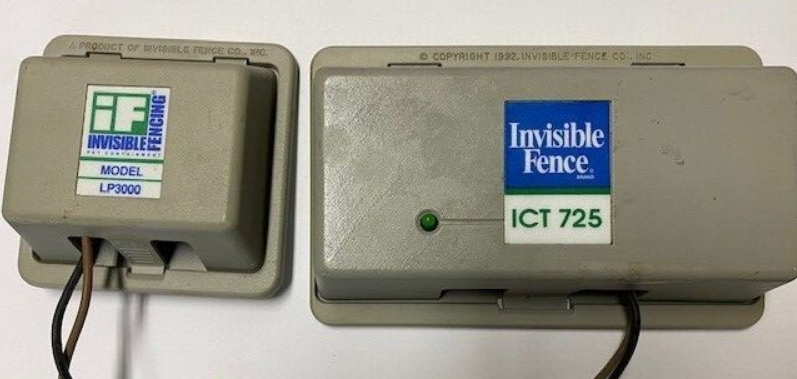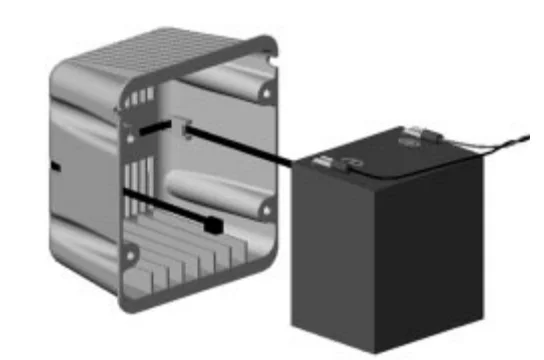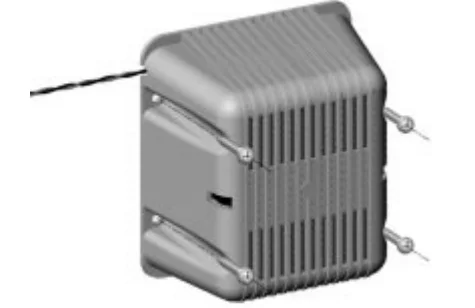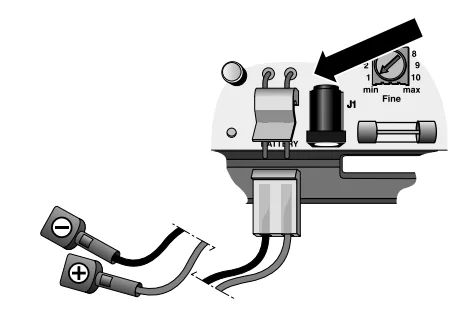
Invisible Fence ICT-725 Transmitter
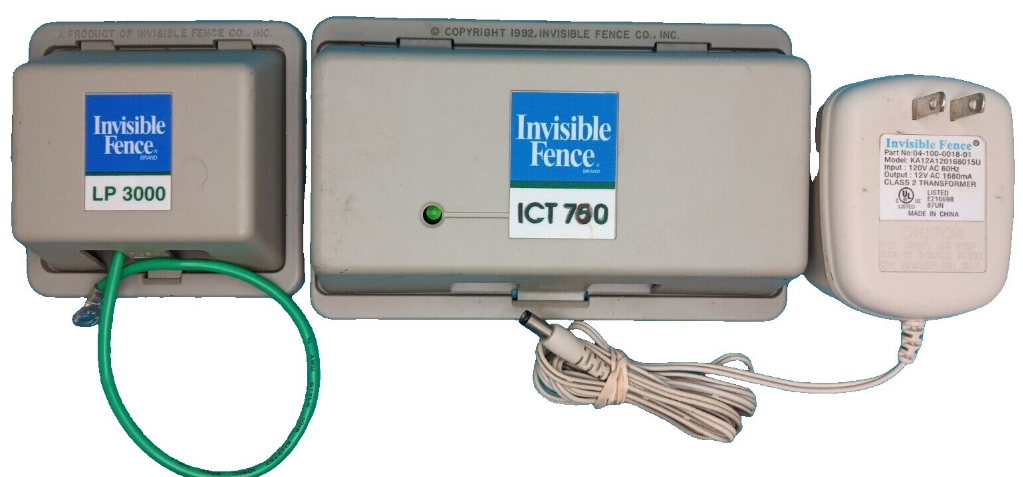
Thank you for purchasing an Invisible Fence® Pet Containment System.
We believe that you now own the highest-quality electronic pet containment system made anywhere. We support this claim by backing Invisible Fence® Brand products with a One-Year, Money-Back Performance Guarantee, and new warranties that include lightning and surge damage.
Refer to your warranty card or the back of your sales contract for complete details. All of this is backed up by our international network of local dealers who offer our customers professional installation, animal training, and prompt service. You are the most important judge of our products and services. When you tell us that we have met or exceeded your expectations for Invisible Fencing products, then we are achieving our goal: to continuously keep your pet safe at home.
ICT 725 Installation
The ICT 725 Transmitter is microprocessor-controlled and designed to work with an Invisible Fence Computer Collar to contain your pet within the areas that you select, or to teach your pet to avoid specific areas such as a flower bed, garden, or pool. To operate, plug the transformer into the transmitter power jack at J1, and then plug the 12V AC transformer into a 110V AC* electric outlet.
ICT 725 Transmitter Features and Functions
The ICT 725 Invisible® pet containment system is designed for systems up to 3,000 feet of loop wire and up to 150 feet of twisted pair. The ICT 725 has a green LED to indicate that power is on and there is no break in the loop wire. This LED is ON for 1 second and then OFF for 4 seconds. The LED turns red when the transmitter is in battery backup mode.
The ICT 725 has both an audible and visual BreakAlert®. Should a break occur in the loop wire, the green/red LED will stay on without blinking, and the BreakAlert will sound an alarm. This alarm will continue until the break is repaired or the unit is turned OFF and disconnected from the 12V AC transformer. The ICT 725 also has a coarse and a fine signal field adjustment knob, and a switch that changes the channel of operation between 10k (UP position) and 7k (DOWN position).
Lightning and surge protection is provided by an LP Card that is plugged into the right side of the circuit board. The signal from the transmitter must pass through the LP Card to the signal loop wire. If the LP Card is damaged or removed from the circuit board, the LED will stay on without blinking, and the BreakAlert will sound as previously described. Another feature of the ICT 725 is internal battery backup circuitry that will charge an external 12V battery. With a charged 12V battery, the ICT 725 will power the loop if AC electric power is lost.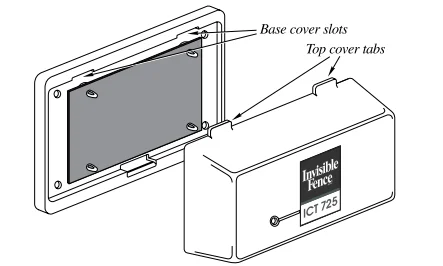
Removing the ICT 725 Cover
To remove the cover on the transmitter, hold the base cover of the transmitter in one hand and, using the thumb and index finger of your other hand, gently compress the top and bottom of the top cover plate and remove it.
To replace the cover on the ICT 725, line up the two tabs on top of the cover plate with the two insert slots located on the top of the base, and insert the tabs into the slots. Lock the cover in place by inserting the bottom tab of the cover plate into the bottom slot of the base.
Installing the Signal Loop
The Signal Field
Invisible Fence® transmitters produce a coded, low-power radio signal that travels from the transmitter along the signal field loop wire and back to the transmitter to produce an Invisible Barrier® wall. This signal is what activates your pet’s receiver collar.
The ICT 725 transmitter functions only when the signal loop wire forms a continuous loop. The signal field is created where two sides of the wire are separated and canceled, and where two sides are kept close together. Should a break occur in the signal field loop wire, the signal field will be lost, and the system will cease to function.
Planning the Installation
The ICT 725 pet containment system is designed for signal loops up to 3,000 feet long and with up to 150 feet of twisted pair. There is no hazard in touching or exposing the wire because the wire carries only low-voltage electricity.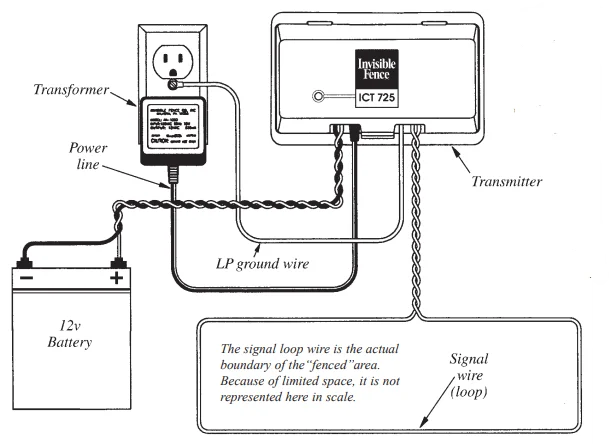
Mount the transmitter in a dry location, near a grounded 110V electric outlet that offers easy access to the outside. A garage or basement is the best location. If you are not sure whether your outlet is grounded or not, contact your local Invisible Fence professional or an electrician. For easy mounting on a wall, use #8 or #10 pan-head sheet screws through the four mounting holes in the base of the transmitter case.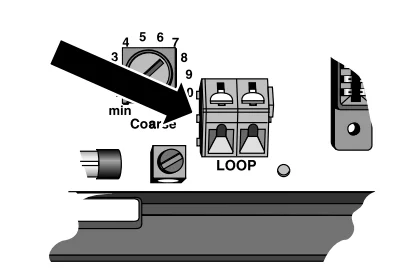
Connecting the Loop Wire
To connect the signal loop wire to the ICT 725 transmitter, strip approximately 1/4 inch of insulation off each end of the loop wire. Twist the ends of the wire to keep the strands together. Using your thumb, push back and down hard on the tabs located on top of the loop wire connector on the right side of the circuit board, and put one of the stripped ends of the loop wire into each of the slots in the base of the connector. Either end of the wire may be put into either slot. Take care that a strand from one wire end does not touch the other wire end or the other connector slot.
Note: You will need to apply pressure to push down the tabs on the wire connector; the connector will not break, so do not be concerned about pushing too hard.
When the ends of the wire are in the slots of the loop wire connector, release your thumb, and the loop wire will automatically be crimped into the connector.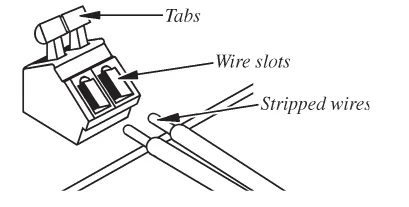
To remove the loop wire from the connector, push back and down on the white tabs on the connector and pull the ends of the loop wire out.
Grounding the System
Connecting the Grounding Wire to the ICT 725 Circuit Board
Put the grounding wire pin into the square screw clamp marked EARTH on the transmitter circuit board. Be careful not to push the pin too far through the connector. The grounding wire pin must not touch any other component on the circuit board. Use a flat-head screwdriver with a 1/8 inch wide blade to tighten the connector screw only enough so that it is snug against the ground wire pin. Then tighten the screw an additional 1/4 turn.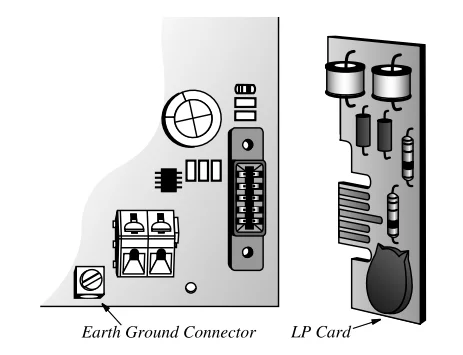
Note: DO NOT tighten the screw more than a 1/4 turn when tightening the grounding wire screw clamp. Over-tightening the screw that holds the grounding wire pin may shear off or fracture the EARTH ground connector and greatly reduce the quality of the electrical connection. A sound earth ground connection is essential and required for lightning protection and the safety of the system.
Caution: Never use a transmitter when the EARTH ground connector on the circuit board is partially sheared or fractured.
Grounding Instructions to an Electric Outlet
Check to make sure that the LP Card is plugged into the LP connector on the right side of the transmitter circuit board.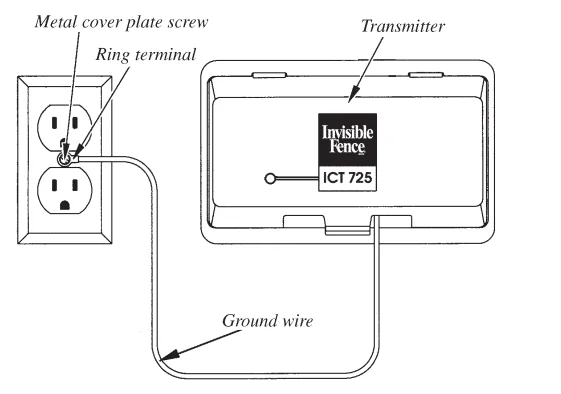
Remove the screw that holds the cover on the 110V electric outlet. Put this screw through the grounding wire ring terminal. Then, put the screw with the ring terminal through the outlet cover plate and secure it in the outlet. The grounding wire must be on the outside of the outlet cover when you replace it. If the cover plate screw is plastic, replace it with a size 6-32 x 1/2” oval-head metal screw.
Important: During the grounding procedure, make certain that the screw and mating outlet threads are clean. All foreign substances, like paint, corrosion, grease, and dirt, must be removed. There must be metal-to-metal contact of the mating threads. Also, the underside of the cover plate screw and the ring terminal must be clean. If the surfaces appear corroded, scrape, wire brush, or sand each thoroughly, or replace them.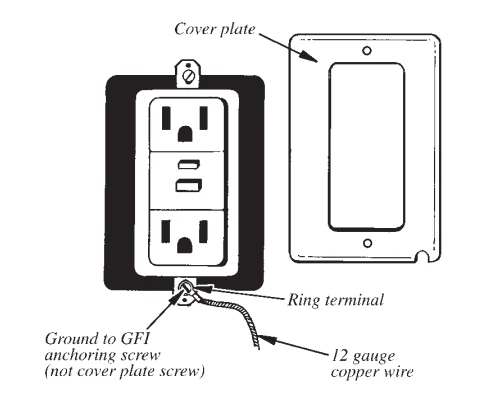
Grounding Instructions to a Ground Fault Interrupter (GFI)
Definition: A ground fault interrupter provides a function similar to a circuit breaker. When it detects a ground fault in the circuit’s electric current, the GFI trips and cuts the power. A ground fault is an abnormal electrical condition that is not desirable.
- Remove the outlet cover plate.
- Remove the bottom screw holding the GFI outlet in the junction box.
- Put the screw through the grounding wire ring terminal.
- Refasten the screw with the ring terminal on it to the GFI junction box and tighten it.
- Notch the bottom edge of the cover plate approximately the size of the 12-gauge grounding wire. Bend the wire to fit into the notch and reattach the cover plate, keeping the wire in the notch.
Caution: DO NOT make any sharp bends in the grounding wire. An LP Card helps protect the transmitter from lightning and surge damage. The LP Card must be plugged into the Loop LP connector for the signal to be transmitted to the signal field loop wire.
ICT 725 12v AC Transformer
Only use the 12v AC transformer provided with the ICT 725 by your authorized Invisible Fence® professional, Invisible Fence part number 100-0018-01.
Specifications:
- INPUT: 120v AC 60Hz 33.5W
- OUTPUT: 12v AC 1667mA
- UL/CSA CLASS 2 Transformer
- UL-listed/CSA-certified
This transformer will accommodate the power requirements needed to properly power the ICT 725. Using any other transformer that is not authorized by IFCO Enterprises, Inc. may result in a malfunction of the ICT 725 system.
Setting the Signal Field
The signal field is what activates your pet’s Computer Collar. The signal field can be set to various distances from the loop wire, depending on the layout and size of your property. The average setting of the signal field is 6 to 10 feet wide.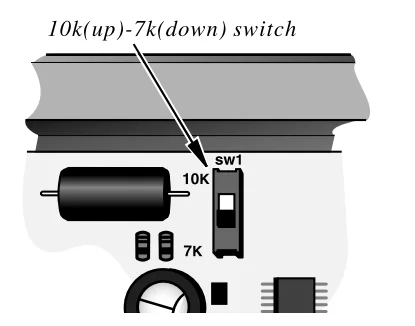
Check to be sure that the transmitter is turned on and that the channel of operation switch is set to the same frequency as the receiver collar, 10k or 7k. The switch is labeled SW1; the 10k setting is UP, and the 7k setting is DOWN. There are two signal field adjustment knobs on the ICT 725 circuit board. The right knob is the coarse signal field adjustment and is numbered 1 to 10.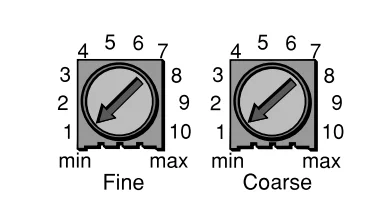
The left knob is the fine-tune signal field adjustment and is also numbered 1 to 10. Turning the signal field adjustment knobs clockwise increases the width of the signal field. By first tuning the coarse signal field adjustment and then using the fine-tune signal field adjustment, you can set the width of the signal field to the desired distance.
For example, on a one-acre property, the fine-tune adjustment can be used to move the signal field, which has been set by the coarse adjustment, to protect a planter or exclude a walk or driveway. These adjustments do not alter the level of correction from the receiver; they change the width of the signal field sent out from the signal field loop wire.
Checking the Signal Field
You can check the width of the signal field by holding a Computer Collar® parallel to the loop wire. Hold it at the same height and angle that your pet will be wearing the collar. Approach the wire. The Computer Collar will sound a warning when it reaches the edge of the signal field.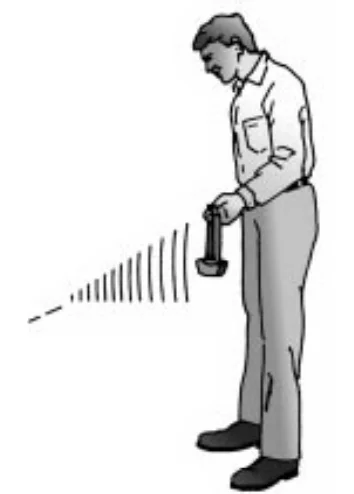
Note: A Computer Collar has a fail-safe mechanism. The Computer Collar receiver will go through three complete cycles of 10 seconds on and 10 seconds off before it shuts down. It will not reactivate until it is taken completely out of the signal field and then brought back into it.
Installing a Battery Backup
A 12V battery connected to an ICT 725 will power the signal field loop in the event of a power outage. A 12V battery with a 5.0 Ah (amp hours) rating will power the system for approximately 10 hours with the signal set at maximum. The greater the amp hours (Ah) and/or the lower the signal field is set, the longer the system will function without AC power. The green LED will turn red, indicating that AC power is lost and the system is operating in battery backup mode.
Recommended Batteries
- All are 12v, 5.0Ah:
- Power Mate®, PM1255
- Power Sonic®, PS-1252
- Panasonic®, LCR12V5P
- Cel-Con, PN 90195 (available from your Invisible Fence® professional)
Note: The 12V lead-acid battery has a five-year shelf life and should be replaced, whether engaged often or not, after that time.
Important: The battery will take five times its projected operating time to fully charge. A 5.0Ah battery will take about 50 hours to charge to full power. Charging of the external battery occurs while the system is operating normally on AC electric power.
Note: NEVER leave the 12V battery directly on the floor or ground. This may lead to premature battery failure. USE ONLY approved lead-acid batteries. Using non-lead-acid batteries or batteries with improper voltage can damage both the transmitter and the battery.
Select a location for the battery near the transmitter, but not on the floor or ground. Put the battery on a shelf or in a battery box.
Installing a Battery Box
- Hold the battery box on the wall where you are going to mount it. Use the box as a template and mark the position of the four screw holes on the wall. Drill four small pilot holes in the wall where the screws will go.
- Lace a 12” wire tie around the inside of the battery box, running the tie all the way around the box to form a “U.”
- Attach the wires to the battery. One red wire (positive + lead) and one black wire (negative – lead) are used to help eliminate confusion. Connect the spade quick-connect on the red wire to the positive (+) terminal of the 12V battery. Connect the spade quick-connect on the black wire to the negative (–) battery terminal.

- Put the battery in the box and secure it by pulling the wire tie tight around it.
- Align the battery box with the battery over the pilot holes in the wall, taking care that the wires from the battery are in one of the exit notches. Fasten the box to the wall with four #10 pan-head sheet metal screws.

- Attach the wire connector from the battery to the transmitter. The battery backup wire connector is located on the transmitter circuit board between the LED and the 12V AC power jack. The two-position header connector is on the lower left side of the circuit board. The plug holds the two inboard ends of the leads that run to the battery, and each wire’s outboard end has a spade quick-connect attached to it. The connector and the plug are designed so that the plug will only go into the connector one way, making it nearly impossible to reverse the battery connections on the transmitter circuit board.

A 2-amp fast-blow fuse is installed on the circuit board to protect the battery and the circuit board from improper installation. If the battery is connected incorrectly, it will cause the fuse to blow.
Detecting Low Voltage in the 12v Battery
The voltage of a fully charged 12V battery is continuously monitored by a microprocessor. When this microprocessor senses that the voltage of the battery has dropped to between 11V DC and 9V DC, the transmitter sounds an alarm. The alarm is a one-second beep that sounds once a minute.
The alarm will continue until AC power is restored and the battery voltage has been recharged to more than 11V DC. The alarm can be manually disabled by disconnecting all power (both the 12V AC transformer and the battery) for 10 seconds. After 10 seconds, reconnect the battery first and then the transformer.
NOTE: When the alarm is manually disabled, it will not sound during a second power outage unless the battery has reached a charge of greater than 11v DC. How long it takes the battery to recharge to 11v DC depends on how low the battery voltage has dropped and what the signal field setting is. The lower the voltage and the higher the signal field setting, the longer the battery will take to recharge to 11V DC.
NOTE: The battery will take five times its projected operation time to charge. The 5.0Ah battery will take about 50 hours to charge to full power. Charging of the external battery occurs while the system is operating normally on AC electric power. When the voltage of the battery drops too low to produce a signal field, the alarm will sound constantly, and the LED will not be lit.
Wire Specs and Service
Wire Specifications
The signal field loop wire is a solid or stranded copper-insulated wire that carries a harmless radio signal. There is no hazard in touching or exposing the wire because it carries only low-voltage electricity. Some installations are unique. These measurements are guidelines for typical installations.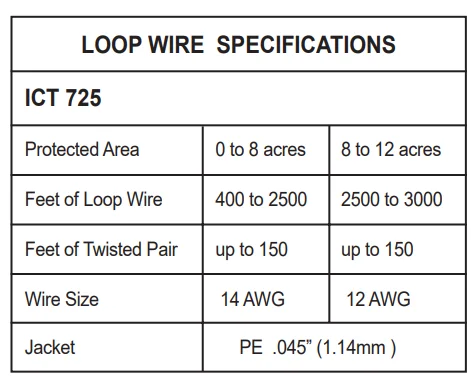
Service Diagnostics
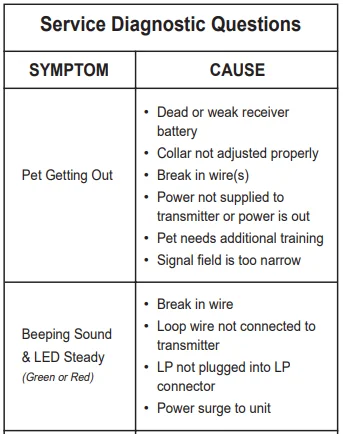
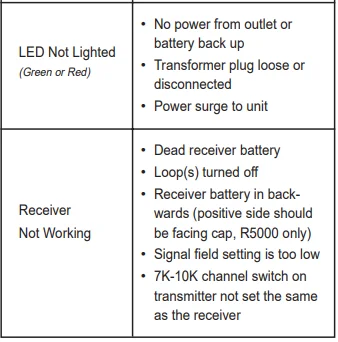
If a problem occurs after the installation is complete, first check the “Service Diagnostic Questions” above to try to determine what the problem may be. If, for any reason, your Invisible Fence® system still does not operate as described in this manual or if you encounter any difficulty training your pet, call your Invisible Fence professional immediately.
FCC ID # KZ31CT250
This device complies with Part 15 of the FCC Rules. Operation is subject to the following two conditions:
- This device may not cause harmful interference, and
- This device must accept any interference received, including interference that may cause undesirable operation.
Changes or modifications not expressly approved by the party responsible for compliance could void the user’s authority to operate the equipment.”
Questions or comments? Please call 1-800-538-DOGS or visit www.invisiblefence.com.
For More Manuals By Invisible Fence, Visit ManualsLibraryy.
Invisible Fence ICT-725 Transmitter-FAQs
Why is my Invisible Fence receiver not working?
If your receiver isn’t functioning, first check the contact posts and ensure the battery cap is secure. Also, verify the transmitter lights — the red light confirms AC power, and the green light shows there’s no wire break in the system.
How do I test if my Invisible Fence transmitter is working?
Disconnect the two wires running from the transmitter to the boundary fence. Insert a small wire or paper clip into the jacks where the wires were connected. If the alarm stops beeping, the transmitter is working fine, and the issue is likely a wire break.
Why is my Invisible Fence transmitter beeping?
A beeping transmitter usually means there’s a break or damage in the boundary wire. You’ll need to locate the broken section and repair it to restore normal operation.
How many volts is an Invisible Fence battery?
Invisible Fence® receiver collars use authorized 3-volt Power Cap® batteries designed specifically for their systems.
How long does an Invisible Fence battery last?
Most Invisible Fence® batteries last 90 to 120 days before needing replacement, depending on use and conditions.
How do I pair an Invisible Fence collar?
Ensure your phone’s Bluetooth is on and the collar is fully charged. When in pairing mode, the collar light will blink slowly. Open the Invisible Fence® app and follow on-screen prompts to complete pairing.
How do I adjust Invisible Fence correction settings?
Open the app, select your dog’s collar, and go to the “Correction Type” option. Follow the instructions to choose or change the correction level based on your pet’s training needs.
Does the Invisible Fence ICT-725 need Wi-Fi?
No, the ICT-725 Transmitter doesn’t require Wi-Fi. It sends out its own signal to the receiver collar, operating independently of any internet connection.
Is an Invisible Fence powered by AC or DC?
AC units plug into a wall outlet and are the most common type for homes. DC versions run on batteries, and you can also connect solar panels for charging if needed.
What voltage does an Invisible Fence operate at?
Most invisible fences emit a radio signal at around 600 kHz, not high-voltage electricity. The static correction on the collar is mild and adjustable for pet safety.

